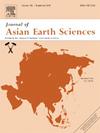内蒙古白云鄂博REE-Nb-Fe矿床矿物中钪的分布与富集
IF 2.4
3区 地球科学
Q2 GEOSCIENCES, MULTIDISCIPLINARY
引用次数: 0
摘要
钪是一种重要的金属,其成矿机制引起了人们的广泛关注。中国北方白云鄂博REE-Nb-Fe矿床是重要的钪资源之一。然而,矿物中Sc的分布和富集仍然知之甚少。本文采用激光烧蚀ICP-MS对20多种矿物中的钪含量进行了系统的研究。结果表明:柱长石(平均钪含量为9100 ppm)、绿镁石(平均钪含量为2200 ppm)、绿镁石[NaFe3+(Si2O6)] (1250 ppm)和锆石(350 ppm)是钪的主要寄主矿物。钪在赤铁矿、透辉石和辉白石[Na2(Mg, Fe)3Fe2+(Si8O22)(OH)2]中富集,含量在20 ~ 200 ppm之间。其他17种矿物,包括菱灰石、褐长石、白云石、钠长石、铁长石、磁铁矿、磁黄铁矿、钛铁矿、独居石、菱铁矿、parite、金红石、重晶石、磷灰石、方解石、黄铁矿和虫草石,其平均Sc含量低于20ppm。钪可通过Sc3+ + Al3+↔Mg2+ + Ti4+并入锑中,通过Sc3+ + Mg2+↔Al3+ + Fe2+并入锑中。锌的富Sc边缘和贫Sc核心显示Sc的非均匀分布,可能是由溶解-再沉淀过程引起的。流体中不同的F/Cl比是导致稀土和钪富集模式不同的主要原因。由于钪的离子半径与铁、镁的离子半径相似,它更容易与镁基硅酸盐矿物结合。磁铁矿氧化成赤铁矿不能导致Sc富集。所研究的赤铁矿中Sc的升高表明,这是含Sc流体的直接沉淀,而不是磁铁矿的转化。本文章由计算机程序翻译,如有差异,请以英文原文为准。
Distribution and enrichment of scandium in minerals of the Bayan Obo REE-Nb-Fe deposit, Inner Mongolia, north China
Scandium is a critical metal, and its mineralization mechanisms have attracted widespread attention. The Bayan Obo REE-Nb-Fe deposit in northern China is one of the most important Sc resources. However, the distribution and enrichment of Sc in minerals remain poorly understood. This study systematically investigates the Sc contents in over 20 minerals using laser ablation ICP-MS. Results show that columbite (average Sc: 9100 ppm), samarskite (2200 ppm), aegirine [NaFe3+(Si2O6)] (1250 ppm), and zircon (350 ppm) are significant host minerals for Sc. Scandium is variably enriched in hematite, diopside, and riebeckite [Na2(Mg, Fe)3Fe2+(Si8O22)(OH)2], with contents ranging from 20 to 200 ppm. The other 17 minerals, including aeschynite, fergusonite, dolomite, albite, fersmite, magnetite, pyrrhotite, ilmenite, monazite, rhodochrosite, parisite, rutile, barite, apatite, calcite, pyrite, and cordylite, have average Sc contents below 20 ppm. Scandium can be incorporated into aegirine via Sc3+ + Al3+ ↔ Mg2+ + Ti4+ and into riebeckite via Sc3+ + Mg2+ ↔ Al3+ + Fe2+. The Sc-rich rim and Sc-depleted core in aegirine indicate heterogeneous Sc distribution, likely caused by dissolution-reprecipitation processes. Contrasting enrichment patterns of Sc and REE in aegirine are due to various F/Cl ratios in fluids. Scandium preferentially incorporates into mafic silicate minerals due to its similar ionic radius to those of Fe and Mg. Oxidation of magnetite to hematite cannot lead to Sc enrichment. Elevated Sc in studied hematite suggests a direct precipitation from Sc-bearing fluids rather than a transformation from magnetite.
求助全文
通过发布文献求助,成功后即可免费获取论文全文。
去求助
来源期刊

Journal of Asian Earth Sciences
地学-地球科学综合
CiteScore
5.90
自引率
10.00%
发文量
324
审稿时长
71 days
期刊介绍:
Journal of Asian Earth Sciences has an open access mirror journal Journal of Asian Earth Sciences: X, sharing the same aims and scope, editorial team, submission system and rigorous peer review.
The Journal of Asian Earth Sciences is an international interdisciplinary journal devoted to all aspects of research related to the solid Earth Sciences of Asia. The Journal publishes high quality, peer-reviewed scientific papers on the regional geology, tectonics, geochemistry and geophysics of Asia. It will be devoted primarily to research papers but short communications relating to new developments of broad interest, reviews and book reviews will also be included. Papers must have international appeal and should present work of more than local significance.
The scope includes deep processes of the Asian continent and its adjacent oceans; seismology and earthquakes; orogeny, magmatism, metamorphism and volcanism; growth, deformation and destruction of the Asian crust; crust-mantle interaction; evolution of life (early life, biostratigraphy, biogeography and mass-extinction); fluids, fluxes and reservoirs of mineral and energy resources; surface processes (weathering, erosion, transport and deposition of sediments) and resulting geomorphology; and the response of the Earth to global climate change as viewed within the Asian continent and surrounding oceans.
 求助内容:
求助内容: 应助结果提醒方式:
应助结果提醒方式:


